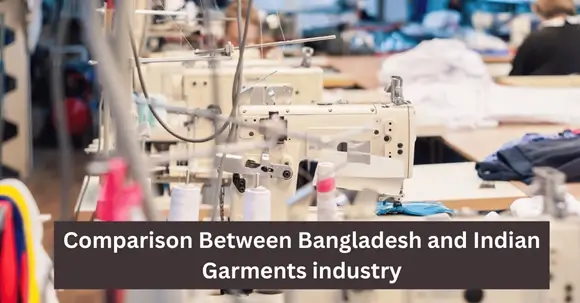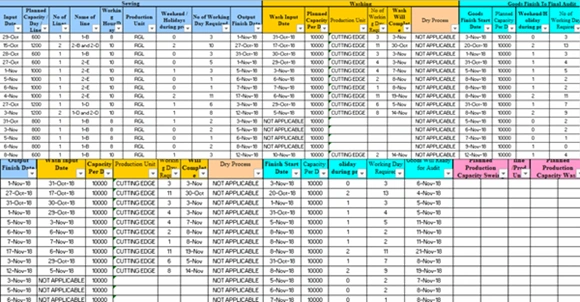Comparison Between Bangladesh and Indian Garments industry
Comparison Between Bangladesh and Indian Garments Industry
Indian Ready-made Garment Industry:
India is one of the biggest exporters of textiles and apparel in the world, the 6th largest as per the current ranking. Where the apparel and textile industry contributes to 5% of the country’s GDP with 12% of the country’s export earnings. This has made the textile and apparel sector a significant contributor to the country’s economy. The technical textiles segment in the country is estimated at $16 bn, which is approximately 6% of the global market. It is one of the largest producers of raw cotton and jute and the 2nd largest producer of silk in the world, Bangladesh is one of the largest importers of raw cotton. The data also shows that 95% of the world’s hand-woven fabric comes from India. In this article, we are discussing the Comparison Between Bangladesh and Indian Garments industry.
The Indian textile and apparel industry employs 45 million people and 100 million people in allied industries making the country the 2nd largest employer of the country. India has also become the second-largest manufacturer of PPE in the world with more than 600 companies certified to produce PPEs today, the segment’s current global market worth is expected to increase by over $92.5 bn by 2025, up from $52.7 bn in 2019.

Bangladesh Ready-made Garment Industry:
Bangladesh is today one of the world’s largest garment exporters, with the RMG sector accounting for 84% of the total country’s exports. The growth of the industry was promoted after massive modernization over the past decade and a stride in improving conditions for the country’s approximately four million garment workers.
The sector saw a fiscal growth from 12.55 percent to $31.456 billion in fiscal 2020-21 ending June 30th in comparison to exports of $27.949 billion in the previous fiscal, as per the provisional data released by the Export Promotion Bureau. The data also showed that the country missed its export target of $33.785 billion by 6.89 %. A comparison category-wise shows growth in knitwear exports from 21.94 % to $16.960 billion in July-June 2020-21 as compared to exports of $13.908 billion during the previous fiscal, as per the data. The woven apparel exports showed growth by 3.24 % to $14.496 billion compared to exports of $14.041 billion for the year 2019-20. The total exports accounted for 81.16 %of $38.758 billion for the last fiscal year.
Comparison Between the Indian and Bangladesh Garment Industry
Despite the lack of infrastructure in Bangladesh, the cost of doing business in the country is still 60% higher than in India, according to the Confederation of Indian Textile Industry, a lobby group based in Delhi. Which has led to the closure of several garment factories in India. Over the years, Indian garment companies have poured millions of dollars into factories in Bangladesh. However, despite this huge investment, their share of the country’s garment market has remained relatively flat. Comparison Between Bangladesh and Indian Garments industry in the following:
The key differences between India and Bangladesh Manufacturing industries are:
Labor Wage
Labor in India is relatively more expensive. An Indian garment worker earns $257 per month, while a Bangladeshi worker gets only $101.
Factory setup cost
The setup cost for a 100,000 sq. ft. factory area in India rounds about $800,000 which when compared to Bangladesh rounds about $500,000 as of 2010.
Lack of infrastructure
The most crucial part of the textile and apparel sector is receiving deliveries on time. Lack of infrastructure and excessive paperwork at ports of India leads to increased transportation time of both raw materials and output, leading to an increase in cost. In contrast, firms in Bangladesh are usually located in a port city. Also, an electronics industry’s estimation shows that logistics, taxes, infrastructure, and land costs are about 12 to 18 % higher in India compared with Bangladesh.
Working hours
Working hours are 10 hours in Bangladesh as compared with 8 working hours in India. It is also a key reason why the production speed of Bangladesh is higher than in India.
Raw material availability
The textile industry is the basis of the apparel industry for raw materials. Bangladesh holds a more productive point here as the textile industries are readily available in Bangladesh making raw materials available for apparel manufacturers.
Country advantage
Since Bangladesh is an LDC (Least Developed Countries) it is allowed duty-free export. The country possesses an advantage in grabbing the global garments export market. Share of the industry in total exports: Total share of apparel exports in Bangladesh is 84% as compared to 12% of India’s export earnings.
Exchange-rate of Rupee and Taka
The overvalued rupee affects the competitiveness of the textile sector as exports become more expensive. To add to that, the Bangladeshi Taka is weaker than the Indian rupee making its exports cheaper. Hence when compared to an exchange rate with the US dollar the exchange rate is more stable in comparison with the Indian Rupee.
Manpower availability
Bangladesh getting manpower more easily than India, as people tend to get involved in IT, sports, and other growing sectors in India. And labor cost are also lower as well
Middle Management Competency/ Skills
Though Bangladesh is a much smaller country than India, Bangladesh has a large number of skilled middle management employees having larger production. Over 50 educational institutes in Bangladesh have graduation/ undergraduate degrees in textile and Fashion, which makes skilled manpower for the garments industry.
Raw Material sourcing
India is very much ahead of Bangladesh on this side. For textile cotton, India is fully self-dependent on sourcing from its own country, whereas Bangladesh has to import all raw materials. Bangladesh is also well behind in garment raw materials sourcing, they have to depend on overseas nations, especially China, India, and Pakistan for sourcing fabrics. Even BD goes to Hong Kong and China to source some high-quality Trims and accessories. In most cases, especially some premium customers nominate all the materials suppliers, so BD has no other options to source by itself.
Conclusion
In both Bangladesh and India, most people are still in the agricultural profession. India is one of the leaders in textile and textile raw material export around the world, whereas Bangladesh is very much behind; Recently (End of 2021) Bangladesh flourished more in the RMG sector. Bangladesh is the 2nd largest garments supplier, whereas India is 6th in the world. Thats all on the Comparison Between Bangladesh and Indian Garments industry.



